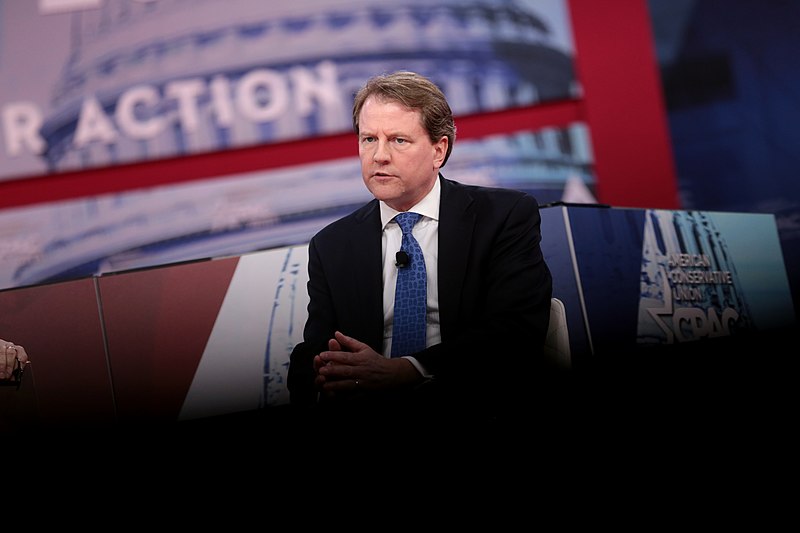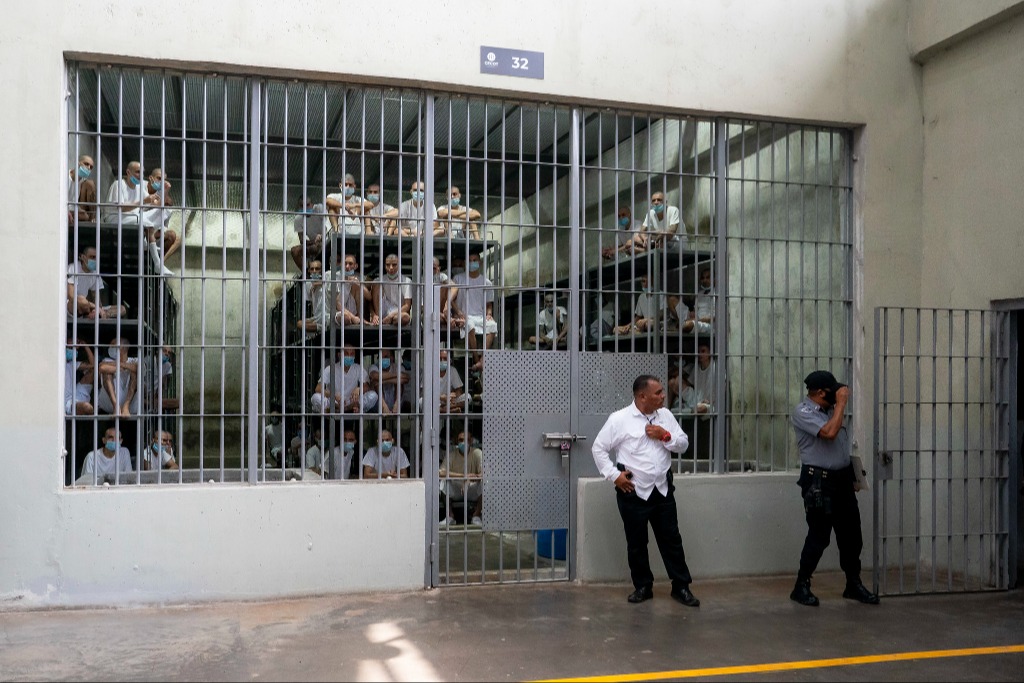En Banc Oral Argument Preview: Committee on the Judiciary v. McGahn
On April 28, the U.S. Court of Appeals for the D.C. Circuit, sitting en banc, will hear oral arguments for Committee on the Judiciary v. McGahn, the case concerning whether the House of Representatives can go to court to enforce subpoenas compelling testimony from Trump administration officials.

Published by The Lawfare Institute
in Cooperation With

On April 28, the U.S. Court of Appeals for the D.C. Circuit, sitting en banc, will hear oral arguments for Committee on the Judiciary v. McGahn, the case concerning whether the House of Representatives can go to court to enforce subpoenas compelling testimony from Trump administration officials. The order granting rehearing en banc vacated a three-judge panel decision from February 2020, which held that the federal courts have no jurisdiction to resolve disputes between the president and Congress over testimony from executive branch officials.
The court is live-streaming audio of the argument––the second case that morning that will be available here at 9:30 a.m. EDT.
Factual and Procedural Background
During Special Counsel Robert Mueller’s investigation into executive branch misconduct, Mueller interviewed then-White House Counsel Don McGahn. After Mueller submitted his final report to the House of Representatives Committee on the Judiciary, the committee ordered McGahn to turn over any documents related to President Trump’s efforts to obstruct the investigation. McGahn refused, so the committee issued a subpoena for the documents and for his in-person testimony. In response, White House Counsel Pat Cipollone informed the committee that the president had instructed McGahn not to testify, asserting that certain presidential advisers possess “absolute testimonial immunity.” The Judiciary Committee then sued McGahn in federal district court in D.C. to enforce its subpoena, asking the court to declare that McGahn’s refusal to testify was “without legal justification.” The district court agreed and instructed McGahn to appear before Congress. McGahn appealed.
A divided three-judge panel of the D.C. Circuit reversed the district court’s decision. Judge Thomas Griffith, writing for himself and Judge Karen LeCraft Henderson, held that the federal judiciary “lack[s] authority to resolve disputes between the Legislative and Executive Branches until their actions harm an entity beyond the federal government.” In accordance with the separation of powers, even if an assertion of privilege interferes with the committee’s efforts to conduct oversight, the assertion does not create a judicially cognizable injury. Thus, the committee does not have standing to enforce its subpoena. In dissent, Judge Judith Rogers argued that the committee has standing because subpoena enforcement is a “traditional and commonplace function of the federal courts.” A more detailed summary of the panel decision is available here.
Following the panel decision, the House Judiciary Committee filed a petition for rehearing en banc, which the full court granted.
The Judiciary Committee’s Supplemental Brief
In its brief for the en banc hearing, the Judiciary Committee asserts that it has standing to challenge McGahn’s refusal to testify. The committee argues that when an executive official defies a congressional subpoena, that official prevents Congress from obtaining information necessary to its legislative, oversight and impeachment powers. The committee notes that denial of information to which the plaintiff believes he or she is entitled has long been recognized as an injury-in-fact. That the party seeking to enforce the subpoena is a congressional committee, rather than a private party, makes the injury more severe, not less: McGahn’s defiance impairs the committee’s performance of its constitutional duties. Thus, the committee concludes, it has suffered a concrete and particularized injury that the court can redress.
The committee argues that, in the past, congressional committees have sued to enforce subpoenas, and courts have uniformly recognized that the committees have standing. In United States v. AT&T, for example, the executive branch sued AT&T to prevent it from complying with a House subpoena, and the D.C. Circuit held that the House could intervene because it had standing to assert its investigative powers. The committee also emphasizes that, in AT&T, the D.C. Circuit read its prior decision in Senate Select Committee on Presidential Campaign Activities v. Nixon to establish that a conflict between the legislative and executive branches over a congressional subpoena does not preclude judicial review. And since the decision in AT&T, the committee observes, the D.C. district court has concluded on three separate occasions that a congressional committee had standing to sue the executive branch over an informational injury.
The committee also argues that the panel improperly relied on the Supreme Court’s decision in Raines v. Byrd. First, the committee states, the panel ignored the limits of the Raines decision: Raines involved a suit by individual legislators, who had not been authorized to represent the full House; the Supreme Court did not determine the outcome of a case in which an authorized House committee subpoenas information from the executive branch. In addition, the committee notes that the Raines plaintiffs raised abstract and widely dispersed injuries. In contrast, the committee here alleges that it has suffered from the specific and acute injury: that McGahn refuses to supply the committee with the testimony it requires. Finally, the committee asserts, Raines did not add a new element of Article III standing that the dispute must be one traditionally thought to be capable of judicial resolution; injury, causation and redressability continue to be the irreducible minimum of constitutional standing.
The Judiciary Committee also takes issue with the panel decision on historical matters. In finding that the committee did not have standing, the panel relied on the absence of subpoena-enforcement suits brought by early Congresses. But, the committee states, in early American history, presidents overwhelmingly complied with congressional inquiries; there was no need to file lawsuits until much more recently, when the executive branch began to refuse congressional requests for information. And even when early presidents did withhold limited information from Congress, those presidents recognized that Congress’s right to information was strongest during an impeachment inquiry.
The committee then addresses the panel’s conclusion that courts cannot resolve any dispute that does not involve individual rights. It responds that courts often decide cases concerning the allocation of power between governmental entities, including interstate disputes and disputes between federal government entities in both the civil and criminal context. Noting the difficulty in distinguishing cases involving the rights of private actors from those involving only interbranch disputes, the committee highlights that here the court is asked to determine whether McGahn––an individual no longer employed by the executive branch––is required to testify.
The committee then suggests that the federal-question statute provides subject matter jurisdiction over House subpoena-enforcement disputes; the statute permitting Senate enforcement suits did not implicitly repeal this federal-question jurisdiction. The panel’s suggestion that a statute expressly authorizing House enforcement suits could create standing directly conflicts with Supreme Court precedent, the committee contends: Congress cannot grant the right to sue to a plaintiff who otherwise would not have constitutional standing.
Finally, the committee then asserts that the panel’s decision upends the separation of powers. According to the committee, the judiciary should resolve subpoena disputes to ensure that Congress can properly check the executive branch, as intended in the Constitution. By preventing Congress from suing to enforce a subpoena, the panel removes any incentive for the executive branch to engage in the accommodations process. The other tools that the panel suggested Congress could use to encourage compliance––a polite request, an unenforceable subpoena, a government shutdown, impeachment without access to the full slate of information, or imprisoning executive officers in contempt of Congress––are all nonviable. The committee concludes: “The system McGahn envisions is one that leaves Congress effectively powerless to hold the Executive accountable and would be unrecognizable to the Framers who designed our system of checks and balances.”
McGahn’s Supplemental Brief
In response, McGahn, represented by Justice Department lawyers, argues that the panel decision was correct because Article III bars judicial resolution of interbranch suits. He emphasizes that historical practice supports this conclusion. For 200 years after the founding, the political branches resolved informational disputes among themselves, without judicial involvement. That history reflects underlying notions of the separation of powers––namely, that courts may only adjudicate concrete disputes over individual rights, not institutional grievances between the branches. McGahn argues that if the D.C. Circuit here decides to adjudicate a purely interbranch dispute, the court would reshape the separation of powers among all three branches. And this would insert courts directly into political power contests, undermining the public confidence that is vital to the functioning of the judiciary.
McGahn asserts that the Supreme Court’s decision in Raines controls the current case. According to McGahn, Raines reaffirmed that Article III standing requires a dispute that is “traditionally thought to be capable of resolution” through the judicial process. While the committee asserts that Raines’s reference to traditional judicial resolution was only a component of Article III’s prohibition on abstract grievances, McGahn argues that the Raines court understood them to be two separate requirements for standing. Indeed, McGahn notes, if the inquiry into traditional judicial resolution were equivalent to asking whether a grievance was abstract, the Raines court’s entire historical analysis would have been superfluous.
Regardless, McGahn concludes, the committee concedes that Raines at least requires consideration of traditional judicial resolution as part of the inquiry into whether an alleged injury is sufficiently concrete and particularized. Looking to history even for that limited purpose, McGahn argues, undermines the committee’s allegations. The court in Raines understood the injury to be abstract because it raised an institutional injury, rather than a personal one. And historical experience shows that institutional injuries are insufficient, whether brought by an individual legislator or by one or both houses of Congress.
McGahn then turns to lower court precedent. He suggests that any pre-Raines decisions on which the committee relies are neither controlling nor persuasive. He notes that the D.C. Circuit decided only two cases concerning congressional lawsuits to enforce subpoenas against the executive branch––both of which were in the 1970s, and neither of which included a meaningful analysis of Article III standing. Thus, according to McGahn, AT&T (where the House was not even a plaintiff) and Senate Select Committee are inapposite. And, significantly, the cases are irreconcilable with Raines. McGahn observes that since Raines, the D.C. Circuit has generally rejected standing for federal legislators. He sums up this line of cases, declaring that the court’s “fleeting diversion” in AT&T and Senate Select Committee from otherwise uniform practice does not amount to proof that interbranch disputes were traditionally amenable to judicial resolution.
In response to the committee’s description of early presidents largely accommodating Congress’s requests for information, McGahn asserts that many presidents––including George Washington and Thomas Jefferson––have withheld information, but Congress did not file any lawsuits to obtain that information for nearly two centuries.
McGahn then states that the committee fails to adequately respond to the panel’s conclusion that the absence of congressional authorization provides additional reason not to hear this dispute. Congress enacted a statute authorizing only the Senate to sue private parties in certain circumstances, and the act’s legislative history reveals that Congress intended to keep disputes between the executive and legislative branch out of the courts.
Returning to Raines, McGahn recognizes that the case technically decides only that individual members of Congress lack Article III standing. But he asserts that the D.C. Circuit cannot limit the case to its facts. According to McGahn, doing so would contradict the court’s reasoning: Raines’s “essential rationale” was that the historical absence of interbranch judicial disputes alleging institutional injuries proves that courts cannot resolve those cases now. Instead, McGahn concludes, Article III contemplates a limited role for federal courts, where they only adjudicate the rights of individual citizens.
Finally, McGahn argues that if the court were to resolve this dispute, it would reshape the separation of powers among all three branches. He suggests that by seeking to enforce a subpoena in court, the committee essentially is trying to exercise executive power to ensure faithful execution of the laws. Congress, instead, should rely on its own legislative powers to compel executive branch compliance. McGahn notes that even if the House finds these powers imperfect, they are still available. The alternative, presented by this case, is worse: If the courts were to resolve political disputes, it would severely damage public confidence in the judiciary. And by stepping into this politically fraught area, the courts would quickly become the go-to venue for disputes over information between the two branches.
McGahn concludes by suggesting that the court can avoid engaging with these serious Article III concerns by holding that Congress foreclosed the committee from bringing suit. However, the D.C. Circuit limited supplemental en banc briefing to the issue of the committee’s Article III standing.
Amicus Briefs
A handful of parties filed amicus briefs for the en banc rehearing. Three of the amicus briefs were filed by former government officials. Former members of Congress filed a brief to emphasize that subpoenas are integral to the House’s oversight powers. Former House general counsels filed a brief to stress that a ruling for the Judiciary Committee will not open the floodgates to excessive litigation. And, finally, former Justice Department employees filed a brief to highlight that the executive branch has explicitly recognized and relied on Congress’s power to bring civil actions to enforce congressional subpoenas.




